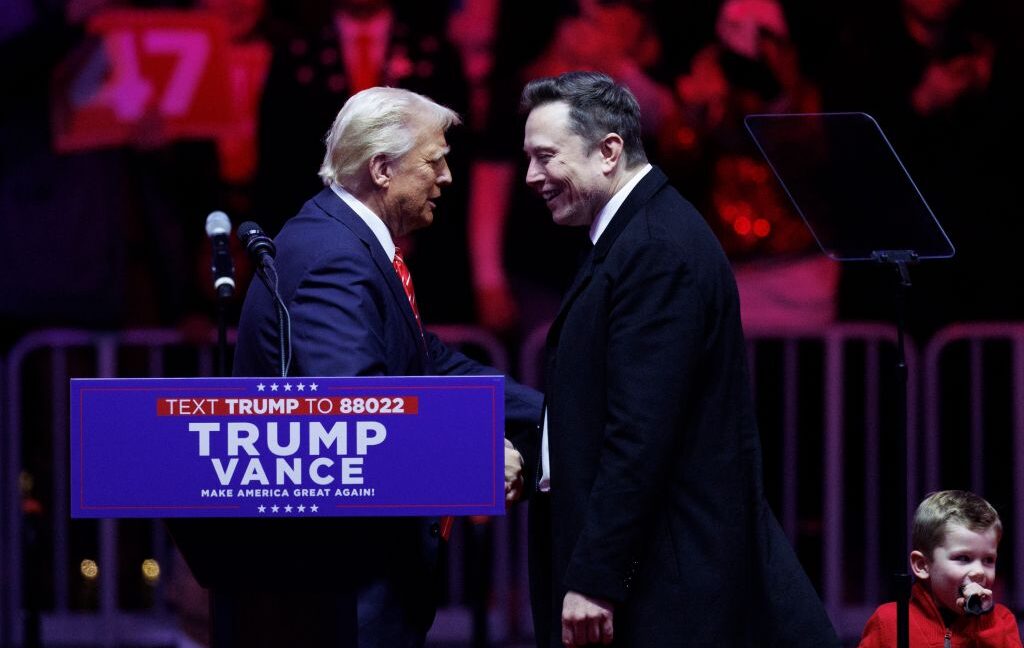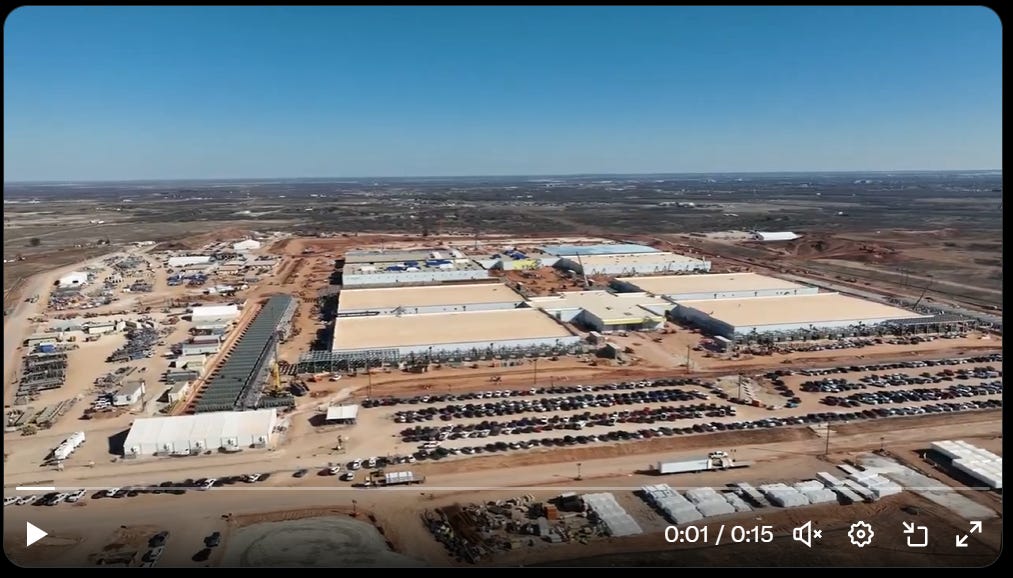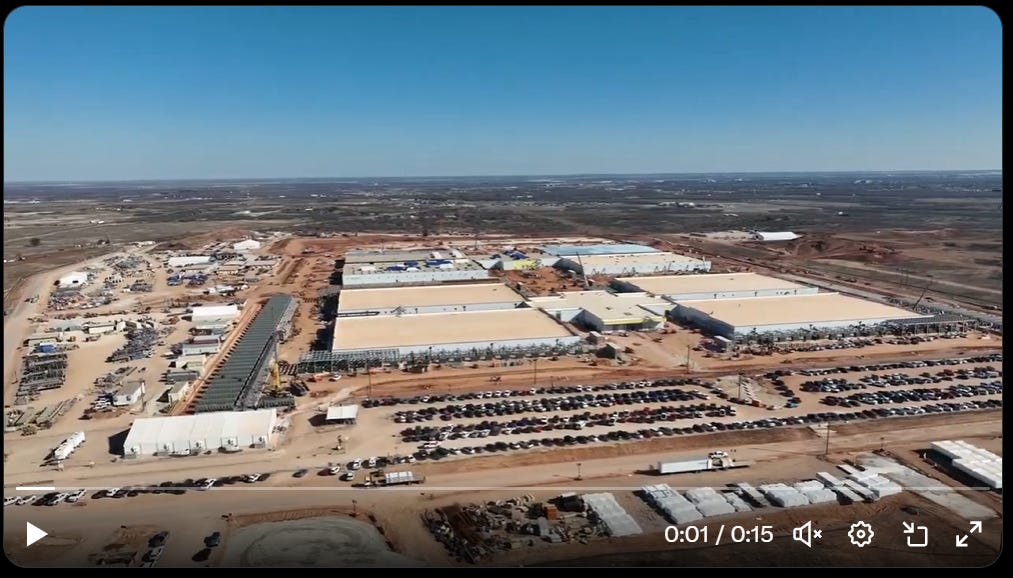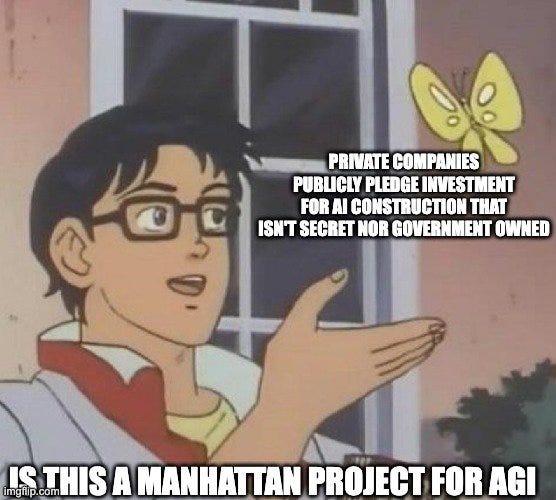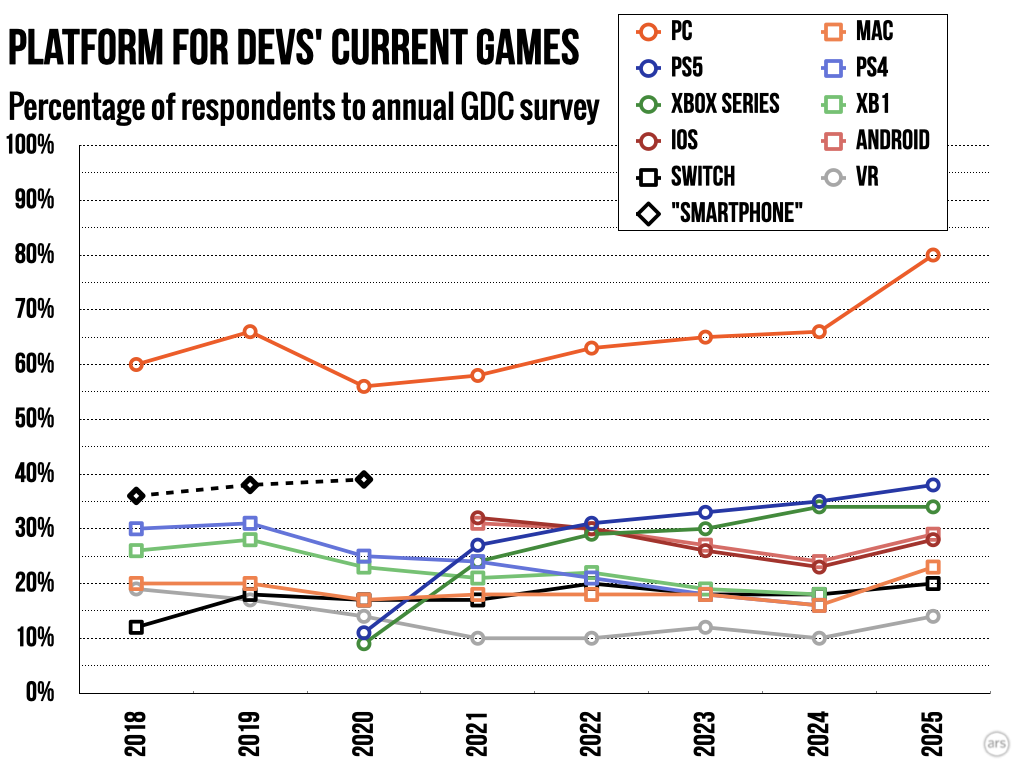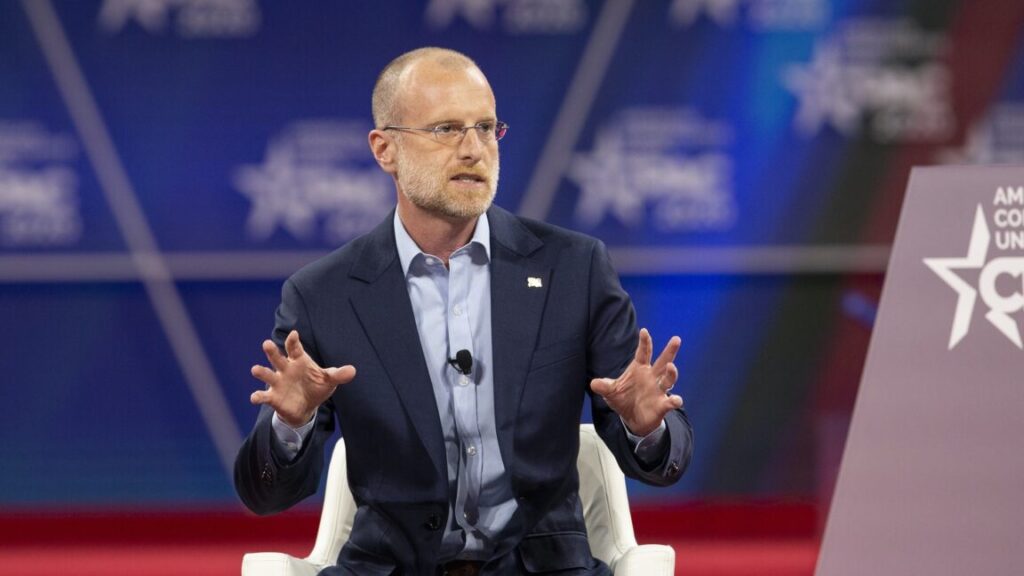There was a comedy routine a few years ago. I believe it was by Hannah Gadsby. She brought up a painting, and looked at some details. The details weren’t important in and of themselves. If an AI had randomly put them there, we wouldn’t care.
Except an AI didn’t put them there. And they weren’t there at random.
A human put them there. On purpose. Or, as she put it:
THAT was a DECISION.
This is the correct way to view decisions around a $500 billion AI infrastructure project, announced right after Trump takes office, having it be primarily funded by SoftBank, with all the compute intended to be used by OpenAI, and calling it Stargate.
-
The Announcement.
-
Is That a Lot?.
-
What Happened to the Microsoft Partnership?.
-
Where’s Our 20%?.
-
Show Me the Money.
-
It Never Hurts to Suck Up to the Boss.
-
What’s in a Name.
-
Just Think of the Potential.
-
I Believe Toast is an Adequate Description.
-
The Lighter Side.
OpenAI: Announcing The Stargate Project
The Stargate Project is a new company which intends to invest $500 billion over the next four years building new AI infrastructure for OpenAI in the United States. We will begin deploying $100 billion immediately.
Note that ‘intends to invest’ does not mean ‘has the money to invest’ or ‘definitely will invest.’ Intends is not a strong word. The future is unknown and indeed do many things come to pass.
This infrastructure will secure American leadership in AI, create hundreds of thousands of American jobs, and generate massive economic benefit for the entire world.
This project will not only support the re-industrialization of the United States but also provide a strategic capability to protect the national security of America and its allies.
One of these things is not like the others. Secure American leadership in AI, generate massive economic benefit for the entire world, provide strategic capability to allies, sure, fine, makes sense, support reindustrialization is a weird flex but kinda, yeah.
And then… jobs? American… jobs? Um, Senator Blumenthal, that is not what I meant.
Pradyumna:
> will develop superintelligence
> create thousands of jobs
????
Samuel Hammond: “We’re going to spend >10x the budget of the Manhattan Project building digital brains that can do anything human brains can do but better and oh, by the way, create over 100,000 good paying American jobs!”
There’s at least some cognitive dissonance here.
Arthur B: The project will probably most likely lead to mass unemployment but in the meantime, there’ll be great American jobs.
If you listen to Altman’s announcement, he too highlights these ‘hundreds of thousands of jobs.’ It’s so absurd. Remember when Altman tried to correct this error?
The initial equity funders in Stargate are SoftBank, OpenAI, Oracle, and MGX. SoftBank and OpenAI are the lead partners for Stargate, with SoftBank having financial responsibility and OpenAI having operational responsibility. Masayoshi Son will be the chairman.
Arm, Microsoft, NVIDIA, Oracle, and OpenAI are the key initial technology partners.
If you want to spend way too much money on a technology project, and give the people investing the money a remarkably small share of the enterprise, you definitely want to be giving Masayoshi Sun and Softbank a call.
“Sam Altman, you are not crazy enough. You need to think bigger.”
The buildout is currently underway, starting in Texas, and we are evaluating potential sites across the country for more campuses as we finalize definitive agreements.
This proves there is real activity, also it is a tell that some of this is not new.
As part of Stargate, Oracle, NVIDIA, and OpenAI will closely collaborate to build and operate this computing system. This builds on a deep collaboration between OpenAI and NVIDIA going back to 2016 and a newer partnership between OpenAI and Oracle.
This also builds on the existing OpenAI partnership with Microsoft. OpenAI will continue to increase its consumption of Azure as OpenAI continues its work with Microsoft with this additional compute to train leading models and deliver great products and services.
Increase consumption of compute is different from Azure as sole compute provider. It seems OpenAI expects plenty of compute needs to go around.
All of us look forward to continuing to build and develop AI—and in particular AGI—for the benefit of all of humanity. We believe that this new step is critical on the path, and will enable creative people to figure out how to use AI to elevate humanity.
Can’t stop, won’t stop, I suppose. ‘Enable creative people to elevate humanity’ continues to miss the point of the whole enterprise, but not as much as talking ‘jobs.’
Certainly $500 billion for this project sounds like a lot. It’s a lot, right?
Microsoft is investing $80 billion a year in Azure, which is $400 billion over 5 years, and I’d bet that their investment goes up over time and they end up spending over $500 billion during that five year window.
Haydn Belfield: Stargate is a remarkable step.
But, to put it into context, Microsoft will spend $80 billion on data centers this year, over half in the U.S.
Stargate’s $100 billion this year is more, but a comparable figure.
Rob S.: This is kind of misleading. Microsoft’s spend is also enormous and wildly out of the ordinary. Not normal at all.
Haydn Belfield: Definitely true, we’re living through a historic infrastructure build out like the railways, interstate highways or phone network
What I want to push back on a bit is that this is *the onlyeffort, that this is the manhattan/Apollo project
The number $500 billion is distributed throughout many sites and physical projects. If it does indeed happen, and it is counterfactual spending, then it’s a lot. But it’s not a sea change, and it’s not obvious that the actual spending should be surprising. Investments on this scale were already very much projected and already happening.
It’s also not that much when compared to the compute needs anticipated for the scaling of top end training runs, which very much continue to be a thing.
Yusuf Mahmood: Stargate shouldn’t have been that surprising!
It’s a $500 Bn project that is set to complete by 2029.
That’s totally consistent with estimates from @EpochAIResearch’s report last year on how scaling could continue through 2030.
$500 billion is a lot is to the extent all of this is dedicated specifically and exclusively to OpenAI, as opposed to Microsoft’s $80 billion which is for everyone. But it’s not a lot compared to the anticipated future needs of a frontier lab.
One thing to think about is that OpenAI recently raised money at a valuation of approximately $170 billion, presumably somewhat higher now with o3 and agents, but also potentially lower because of DeepSeek. Now we are talking about making investments dedicated to OpenAI of $500 billion.
There is no theoretical incompatibility. Perhaps OpenAI is mining for gold and will barely recoup its investment, while Stargate is selling pickaxes and will rake it in.
It does still seem rather odd to presume that is how the profits will be distributed.
The reason OpenAI is so unprofitable today is that they are spending a ton on increasing capabilities, and not serving enough inference to make it up on their unit economics, and also not yet using their AI to make money in other ways.
And yes, the equilibrium could end up being that compute providers have margins and model providers mostly don’t have margins. But OpenAI, if it succeeds, should massively benefit from economies of scale here, and its economics should improve. Thus, if you take Stargate seriously, it is hard to imagine OpenAI being worth only a fraction of $500 billion.
There is a solution to this puzzle. When we say OpenAI is worth $170 billion, we are not talking about all of OpenAI. We are talking about the part that takes outside investment. All the dramatic upside potential? That is for now owned by the non-profit, and not (or at least not fully) part of the valuation.
And that is the part that has the vast majority of the expected net present value of future cash flows of OpenAI. So OpenAI the entire enterprise can be worth quite a lot, and yet ‘OpenAI’ the corporate entity you can invest in is only worth $170 billion.
This should put into perspective that the move to a for-profit entity truly is in the running for the largest theft in the history of the world.
Didn’t they have an exclusive partnership?
Smoke-Away: OpenAI and Microsoft are finished. There were signs.
Microsoft was not moving quickly enough to scale Azure. Now they are simply another compute provider for the time being.
Sam Altman: Absolutely not! This is a very important and significant partnership, for a long time to come.
We just need moar compute.
Eliezer Yudkowsky (Quoting Smoke-Away): It is a pattern, with Altman. If Altman realizes half his dreams, in a few years we will be hearing about how Altman has dismissed the U.S. government as no longer useful to him. (If Altman realizes all his dreams, you will be dead.)
Roon: Not even close to being true.
Microsoft is one of the providers here. Reports are that the Microsoft partnership has now been renegotiated, to allow OpenAI to also seek other providers, since Altman needs moar compute. Hence Stargate. Microsoft will retain right of first refusal (ROFR), which seems like the right deal to make here. The question is, how much of the non-profit’s equity did Altman effectively promise in order to get free from under the old deal?
Remember that time Altman promised 20% of compute would go to superalignment, rather than blowing up a sun?
Harlan Stewart: Jul 2023: OpenAI promises to dedicate 20% of compute to safety research
May 2024: Fortune reports they never did that
Jul 2024: After 5 senators write to him to ask if OpenAI will, @sama says yes
It’s Jan 2025. Will OpenAI set aside 20% of this new compute to safety, finally?
Connor Axiotes: @tszzl (Roon), can you push for a significant part of this to be spent on control and alignment and safety policy work?
Roon: I’ll do my part. I’m actually on the alignment team at openai 🙂
So that’s a no, then.
I do expect Roon to push for more compute. I don’t expect to get anything like 20%.
Elon Musk (replying to the announcement): They don’t actually have the money.
Sam Altman: I genuinely respect your accomplishments and think you are the most inspiring entrepreneur of our time.
Elon Musk (continuing from OP): SoftBank has well under $10 billion secured. I have that on good authority.
Sam Altman: Wrong, as you surely know.
Want to come visit the first site already under way?
This is great for the country. I realize what is great for the country is not always what is optimal for your companies, but in your new role, I hope you will mostly put the United States first.
Satya Nadella (CEO Microsoft, on CNBC, when asked about whether Stargate has the money, watch the clip at the link his delivery is perfect): All I know is, I’m good for my $80 billion.
If you take the companies collectively, they absolutely have the money, or at least the ability to get the money. This is Microsoft and Nvidia. I have no doubt that Microsoft is, as its Nadella affirmed, ‘good for its $80 billion.’
That doesn’t mean SoftBank has the money, and SoftBank explicitly is tasked with providing the funding for Stargate.
Nor does the first site in Texas prove anything either way on this.
Remember the wording on the announcement: “which intends to invest $500 billion over the next four years.”
That does not sound like someone who has the money.
That sounds like someone who intends to raise the money. And I presume SoftBank has every expectation of being able to do so, with the aid of this announcement. And of working out the structure. And the financing.
Mario Nawfal: Sam Altman’s grand plan to build “Stargate,” a $500 billion AI infrastructure exclusively for OpenAI, is already falling apart before it even starts.
There’s no secured funding, no government support, no detailed plan, and, according to insiders, not even a clear structure.
One source bluntly admitted:
“They haven’t figured out the structure, they haven’t figured out the financing, they don’t have the money committed.”
Altman’s pitch? SoftBank and OpenAI will toss in $15 billion each and then just… hope the rest magically appears from investors and debt.
For someone obsessed with making AI smarter than humans, maybe he should try getting the basics right first – like not creating something that could destroy all of humanity… Just saying.
But that’s why you say ‘intend to invest’ rather than ‘will invest.’
Things between Musk and Altman did not stop there, as we all took this opportunity to break open the International Popcorn Reserve.
Elon Musk: Altman literally testified to Congress that he wouldn’t get OpenAI compensation and now he wants $10 billion! What a liar.
Musk’s not exactly wrong about that. He also said and retweeted other… less dignified things.
It was not a good look for either party. Elon Musk is, well, being Elon Musk. Altman is trying to throw in performative ‘look at me taking the high road’ statements that should fool no one, not only the one above but also:
Sam Altman: just one more mean tweet and then maybe you’ll love yourself…
Teortaxes (quoting Altman saying he respects Elon’s accomplishments above): I find both men depicted here unpleasant and engaging in near-psychopathic behavior, and I also think poorly of those who imagine Sam is trying to “be the bigger man”.
He’s a scary manipulative snake. “Well damn, fyou too Elon, we have it” would be more dignified.
There’s a subtle art to doing this sort of thing well. The Japanese especially are very good at it. All of this is, perhaps, the exact opposite of that.
Sam Altman: big. beautiful. buildings. stargate site 1, texas, january 2025.
Altman, you made it weird. Also guache. Let’s all do better.
Trump world is not, as you would expect, thrilled with what Musk has been up to, with Trump saying he is ‘furious,’ saying he ‘got over his skis.’ My guess is that Trump ‘gets it’ at heart, because he knows what it’s like to hate and never let something go, and that this won’t be that big a deal for Musk’s long term position, but there is high variance. I could easily be wrong about that. If I was Musk I would not have gone with this strategy, but that statement is almost always true and why I’m not Musk.
This particular Rule of Acquisition is somewhat imprecise. It’s not always true.
But Donald Trump? Yeah. It definitely never hurts to suck up to that particular boss.
Sam Altman (January 22, 2025): watching @potus more carefully recently has really changed my perspective on him (i wish i had done more of my own thinking and definitely fell in the npc trap).
i’m not going to agree with him on everything, but i think he will be incredible for the country in many ways!
Altman does admit this is a rather big change. Anyone remember when Altman said “More terrifying than Trump intentionally lying all the time is the possibility that he actually believes it all” or when he congratulated Reid Hoffman for helping keep Trump out of power? Or “Back to work tomorrow on a new project to stop Trump?” He was rather serious about wanting to stop Trump.
You can guess what I think he saw while watching Trump to make Altman change his mind.
So they announced this $500 billion deal, or at least a $100 billion deal with intent to turn it into $500 billion, right after Trump’s inauguration, with construction already underway, with a press conference on the White House lawn.
And the funds are all private. Which is great, but all this together also raises the obvious question: Does Trump actually have anything to do with this?
Matthew Yglesias: They couldn’t have done it without Trump, but also it was already under construction.
Daniel Eth: Okay, it’s not *Trump’sAI plan. He announced it, but he neither developed nor is funding it. It’s a private initiative from OpenAI, Softbank, Oracle, and a few others.
Jamie Bernardi: Important underscussed point on the OpenAI $100bn deal: money is not coming from the USG.
Trump is announcing a private deal, whilst promising to make “emergency declarations” to allow Stargate to generate its own electricity (h/t @nytimes).
Musk says 100bn not yet raised.
Peter Wildeford: Once upon a time words had meaning.
Jake Perry: I’m still not clear why this was announced at the White House at all.
Peter Wildeford: Trump has a noted history of announcing infrastructure projects that were already in progress – he did this a lot in his first term.
Jacques: At least we’ll all be paperclipped with a USA flag engraved on it.
Trump says that it is all about him, of course:
Donald Trump: This monumental undertaking is a resounding declaration of confidence in America’s potential under a new president.
…
The president said Stargate would create 100,000 jobs “almost immediately” and keep “the future of technology” in America.
I presume that in addition to completely missing the point, this particular jobs claim is, technically speaking, not true. But numbers don’t have to be real in politics. And of course, if this is going to create those jobs ‘almost immediately’ it had to have been in the works for a long time.
Shakeel: I can’t get over the brazen, brazen lie from Altman here, saying “We couldn’t do this without you, Mr President”.
You were already doing it! Construction started ages ago!
Just a deeply untrustworthy man — you can’t take anything he says at face value.
Dylan Matthews: Everything that has happened since the board fired him has 100% vindicated their view of him as deeply dishonest and unreliable, and I feel like the popular understanding of that incident hasn’t updated from “this board sure is silly!”
[Chubby: Sam Altman: hype on twitter is out of control. Everyone, chill down.
Also Sam Altman: anyways, let’s invest half a trillion to build a digital god and cure cancer one and for all. Oh, and my investors just said that AGI comes very, very soon and ASI will solve any problem mankind faces.
But everyone, calm down 100x]
I agree with Dylan Matthews that the board’s assessment of Altman as deeply dishonest and unreliable has very much been vindicated, and Altman’s actions here only confirm that once again. But that doesn’t mean that Trump has nothing to do with the fact that this project is going forward, with this size.
So how much does this project depend on Trump being president instead of Harris?
I think the answer is actually a substantial amount.
In order to build AI infrastructure in America, you need three things.
-
You need demand. Check.
-
You need money. Check, or at least check in the mail.
-
You need permission to actually build it. Previously no check. Now, maybe check?
Masayoshi Sun: Mr. President, last month I came to celebrate your winning and promised $100B. And you told me go for $200B. Now I came back with $500B. This is because as you say, this is the beginning of the Golden Age. We wouldn’t have decided this unless you won.
Sam Altman: The thing I really deeply agree with the president on is, it is wild how difficult it has become to build things in the United States. Power plants, data centres, any of that kind of stuff.
Does Sun have many good reasons to pretend that this is all because of Trump? Yes, absolutely. He would find ways to praise the new boss either way. But I do think that Trump mattered here, even if you don’t think that there is anything corrupt involved in all this.
Look at Trump’s executive orders, already signed, about electrical power plants and transmission lines being exempt from NEPA, and otherwise being allowed to go forwards. They can expect more similar support in the future, if they run into roadblocks, and fewer other forms of regulatory trouble and everything bagel requirements across the board.
Also, I totally believe that Sun came to Trump and promised $100 billion, and Trump said go for $200 billion, and Sun now is at $500 billion, and I think that plausibly created a lot of subsequent investment. It may sound stupid, but that’s Grade-A handling of Masayoshi Sun, and exactly within Trump’s wheelhouse. Tell the man who thinks big he’s not thinking big enough. Just keep him ramping up. Don’t settle for a big win when you can go for an even bigger win. You have to hand it to him.
It is so absurd that these people, with a straight face, decided to call this Stargate.
They wanted to call it the Enterprise, but their lawyers wouldn’t let them.
Was SkyNet still under copyright?
Agus: Ah, yes. Of course we’re naming this project after the fictitious portal through which several hostile alien civilizations attempted to invade and destroy Earth.
I just hope we get the same amount of completely unrealistic plot armor that protected Stargate Command in S.G.1.
Roon: the Stargate. blasting a hole into the Platonic realm to summon angels. First contact with alien civilizations.
Canonically, the Stargates are sometimes used by dangerous entities to harm us, but once humanity deals with that, they end up being quite useful.
Zvi Mowshowitz: Guy who reads up on the canonical history of Stargate and thinks, “Oh, all’s well that ends well. Let’s try that plan.”
Roon: 🤣
Is this where I give you 10,000 words on the history of Stargate SG-1 and Stargate Atlantis and all the different ways Earth and often also everyone else would have been enslaved or wiped out if it wasn’t for narrative causality and plot armor, and what would have been reasonable things to do in that situation?
No, and I am sad about that, despite yes having watched all combined 15 seasons, because alas we do not currently have that kind of time. Maybe later I’ll be able to spend a day doing that, it sounds like fun.
But in brief about that Stargate plan. Was it a good plan? What were the odds?
As is pointed out in the thread (minor spoilers for the end of season 1), the show actually answers this question, as there is crossover between different Everett branches, and we learn that even relatively early on – before most of the different things that almost kill us have a chance to almost kill us – that most branches have already lost. Which was one of the things that I really liked about the show, that it realized this. The thread also includes discussions of things like ‘not only did we not put a nuclear bomb by the Stargate and use a secondary gate to disguise our location, we wore Earth’s gate code on our fing uniforms.’
To be fair, there is a counterargument, which is that (again, minor spoilers) humanity was facing various ticking clocks. There was one in particular that was ticking in ways Earth did not cause, and then there were others that were set in motion rapidly once we had a Stargate program, and in general we were on borrowed time. So given what was happening we had little choice but to go out into the galaxy and try to develop superior technology and find various solutions before time ran out on us, and it would have been reasonable to expect we were facing a ticking clock in various ways given what Earth knew at the time.
There’s also the previous real life Project Stargate, a CIA-DIA investigation of the potential for psychic phenomena. That’s… not better.
There are also other ways to not be thrilled by all this.
Justin Amash: The Stargate Project sounds like the stuff of dystopian nightmares—a U.S. government-announced partnership of megacorporations “to protect the national security of America and its allies” and harness AGI “for the benefit of all of humanity.” Let’s maybe take a beat here.
Taking a beat sounds like a good idea.
What does Trump actually think AI can do?
Samuel Hammond: Trump seems under the impression that ASI is just a way to cure diseases and not an ultraintelligent digital lifeform with autonomy and self-awareness. Sam’s hesitation before answering speaks volumes.
That’s not how I view the clip at the link. Trump is selling the project. It makes sense to highlight medical advances, which are a very real and valuable upside. It certainly makes a lot more sense than highlighting job creation.
Altman I don’t see hesitating, I see him trying to be precise while also going with the answer, and I don’t like his previous emphasis on jobs (again, no doubt, following Trump’s and his political advisor’s lead) but on the medical question I think he does well and it’s not obvious what a better answer would have been.
The hilarious part of this is the right wing faction that says ‘you want to use this to make mRNA vaccines, wtf I hate AI now’ and trying to figure out what to do with people whose worldviews are that hopelessly inverted.
That moment when you say ‘look at how this could potentially cure cancer’ and your hardcore supporters say ‘And That’s Terrible.’
And also when you somehow think ‘Not Again!’
Eliezer Yudkowsky: Welp, looks like Trump sure is getting backlash to the Stargate announcement from many MAGAers who are outraged that AGIs might develop mRNA vaccines and my fucking god it would be useless to evacuate to Mars but I sure see why Elon wants to
To people suggesting that I ought to suck up to that crowd: On my model of them, they’d rather hear me say “Fyou lunatics, now let’s go vote together I guess” than have me pretend to suck up to them.
Like, on my model, that crowd is deadly tired of all the BULLSHIT and we in fact have that much in common and I bet I can get further by not trying to feed them any BULLSHIT.
There is a deep sense in which it is more respectful to someone as a human being to say, “I disagree with your fing lunacy. Allies?” then to smarm over to them and pretend to agree with them. And I think they know that.
RPotluck: The MAGAsphere doesn’t love you and it doesn’t hate you, but you’re made of arguments the MAGAsphere can use to build the wall.
There’s a certain kind of bullshit that these folks and many other folks are deeply tired of hearing. This is one of those places where I very much agree that it does hurt to suck up to the boss, both because the boss will see through it and because the whole strategy involves not doing things like that, and also have you seen or heard the boss.
My prediction and hope is that we will continue to see those worried about AI killing everyone continue to not embrace these kinds of crazy arguments of convenience. That doesn’t mean not playing politics at all or being some sort of suicidal purist. It does mean we care about whether our arguments are true, rather than treating them as soldiers for a cause.
Whereas we have learned many times, most recently with the fight over SB 1047 and then the latest round of jingoism, that many (#NotAllUnworried!) of those who want to make sure others do not worry about AI killing everyone, or at least want to ensure that creating things smarter than humans faces less regulatory barriers than a barber shop, care very little whether the arguments made on their behalf, by themselves or by others, are true or correspond to physical reality. They Just Didn’t Care.
The flip side is the media, which is, shall we say, not situationally aware.
Spencer Schiff: The AGI Manhattan Project announcement was followed by half an hour of Q&A. Only one reporter asked a question about it. WHAT THE FUCK! This is insane. The mainstream media is completely failing to convey the gravity of what’s happening to the general public.
As noted elsewhere I don’t think this merits ‘Manhattan Project’ for various reasons but yes, it is kind of weird to announce a $500 billion investment in artificial general intelligence and then have only one question about it in a 30 minute Q&A.
I’m not saying that primarily from an existential risk perspective – this is far more basic even than that. I’m saying, maybe this is a big deal that all this is happening, maybe ask some questions about it?
Remember when Altman was talking about how we have to build AGI now because he was worried about a compute overhang? Yes, well.
Between the $500 billion of Stargate, the full-on jingoistic rhetoric from all sides including Anthropic, and the forcing function of DeepSeek with v3 and r1, it is easy to see how one could despair over our prospects for survival.
Unless something changes, we are about to create smarter than human intelligence, entities more capable and competitive than we are across all cognitive domains, and we are going to do so as rapidly as we can and then put them in charge of everything, with essentially zero margin to ensure that this goes well despite it obviously by default getting everyone killed.
Even if we are so fortunate that the technical and other barriers in front of us are highly solvable, that is exactly how we get everyone killed anyway.
Holly Elmore: I am so, so sad today. Some days the weight of it all just hits me. I want to live my life with my boyfriend. I want us to have kids. I want love and a full life for everyone. Some days the possibility that that will all be taken away is so palpable, and grief is heavy.
I’m surprised how rarely I feel this way, given what I do. I don’t think it’s bad to feel it all sometimes. Puts you in touch with what you’re fighting for.
I work hard to find the joy and the gallows humor in it all, to fight the good fight, to say the odds are against us and the situation is grim, sounds like fun. One must imagine Buffy at the prom, and maintain Scooby Gang Mindset. Also necessary is the gamer mindset, which says you play to win the game, and in many ways it’s easiest to play your best game with your back against the wall.
And in a technical sense, I have hope that the solutions exist, and that there are ways to at least give ourselves a fighting chance.
But yeah, weeks like this do not make it easy to keep up hope.
Harlan Stewart: If the new $500b AI infrastructure thing ever faces a major scandal, we’ll unfortunately be forced to call it Stargategate
